
In the era of COVID-19, college faculty have had to make the difficult but necessary transition from face-to-face to online instruction. For those who never have taught online, learning new technology and processes can been overwhelming. As an initial step in transitioning faculty to online instruction, Hartnell College developed a two-week Career Technical Education (CTE) online academy to increase awareness about quality course design and use of the OEI’s Online Course Design Rubric. The academy was funded jointly with Improving Online CTE Pathways Grant (titled Ready | Set | Go) and Perkins funds.
About the DE Academy
The first distance education academy was designed and implemented as a joint effort between the Ready | Set | Go Grant Manager, Carol Hobson, the Peer Online Course Review (POCR) Team, Lindsey Bertomen, Tammy Boates, Tina Esparza-Luna, and Nancy Wheat, and the Instructional Technologist, Laura Otero. To increase faculty’s ability to provide high-quality instruction, the academy had three objectives:
To accomplish these objectives, week 1 (DEW1) with Ms. Otero focused on providing an overview of Canvas and its tools. During the first week, faculty were given a module template and were required to create a course shell. Lessons during the first week included assignments, quizzes, video lectures, and discussion creation; and were completed in faculty course shells. Faculty had deadlines, received grades, and completed lessons in the same way a student would.
After completing and passing DEW1, faculty transitioned to DEW2 where they were provided with additional resources designed to guide them toward the alignment of course content to the rubric. Faculty met on day one for a two-hour synchronous Zoom session to introduce the POCR team, explain the process and the support they would have for the week. The session was recorded. There were no assignments provided for DEW2. The deliverables were the orientation and two weekly modules closely aligned to the Course Design Rubric. POCR team members provided a minimum of four scheduled Zoom hours each of the five days for drop-in session. During the week, one POCR team member monitored the discussion, and other POCR members contributed when they had supporting content or additional information. Participant faculty were assigned a POCR team member to officially review their course for completion, and to offer guidance and suggestions along the way.
Who Participated?
Twenty-six CTE Instructors, representing 13 departments, participated in the academy. Of the 26, 19 completed the first week’s requirements and were able to participate in week 2 of the academy.
Two Key Findings
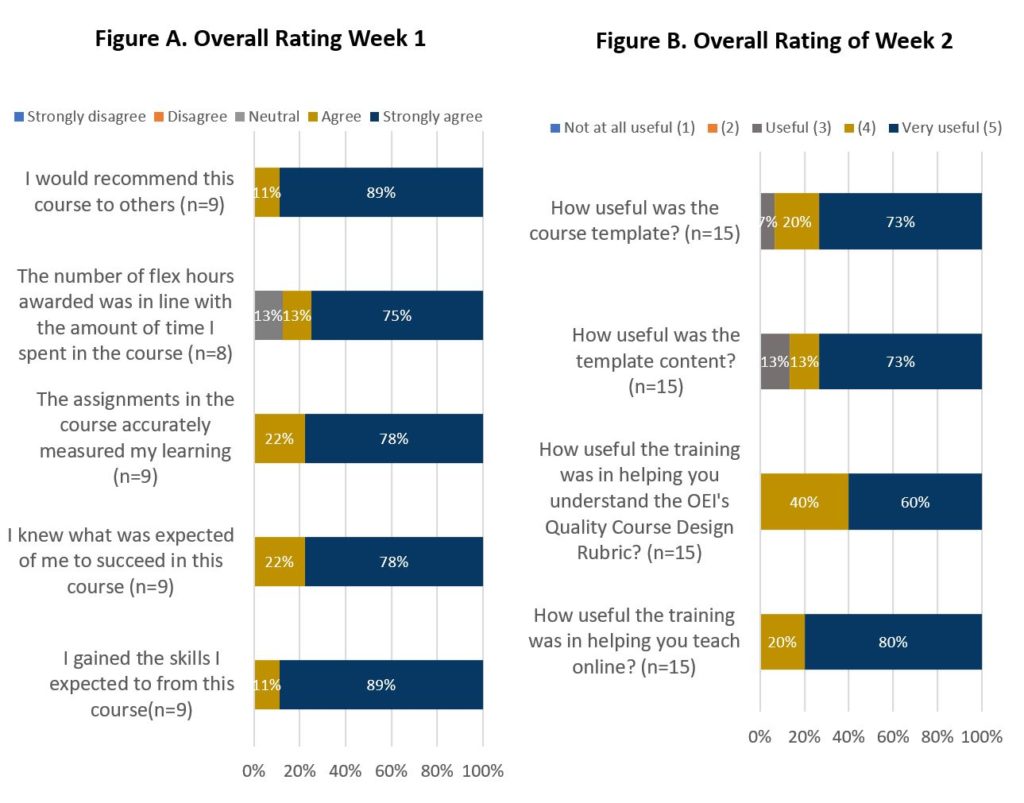
Lessons Learned/ Next Steps
Both faculty who participated in the academy, and the POCR team, recognize the need to adjust the following items for future academies:
For more information about how to set up a distance education academy, or to learn more about Hartnell College’s distance education academy, please contact Carol Hobson.
Author:
Carol Hobson
Distance Education Coordinator
Any opinions, findings, and conclusions or recommendations expressed in this publication are those of the author(s) and do not necessarily reflect the views of the Foothill-De Anza Community College District or those of the California Community College Chancellor's Office.

Instructors never want their own limitations to impact their students. Each edit, modification, and attempt to update an online course is done with the idea that it will make the content learnable for students. But oftentimes we are doing it blind. The OEI rubric taught me how to teach my online class content in a manner that was effective for my students. The benefits are too numerous to summarize; however, one area stands out as the pillar of growth in my online teaching experience. The rubric forced me to create a methodical and structured online course which encourages consistent support and knowledge for the learner from the educator.
In theory structure is simple and something that should already be a part of any course. However, the truth is when we look at our course from an outsider’s perspective it is often not as structured as we believe. Each instructor can use the same learning management system in many different ways. Each student can navigate a course in a number of ways. So, the simple structure that we as educators believe we have created can become complex quickly with all the options. The methodical outline and consistent structure that the OEI rubric encourages helps students know how to utilize this online course in the instructor intended manner. This can be done through videos and structured modules.
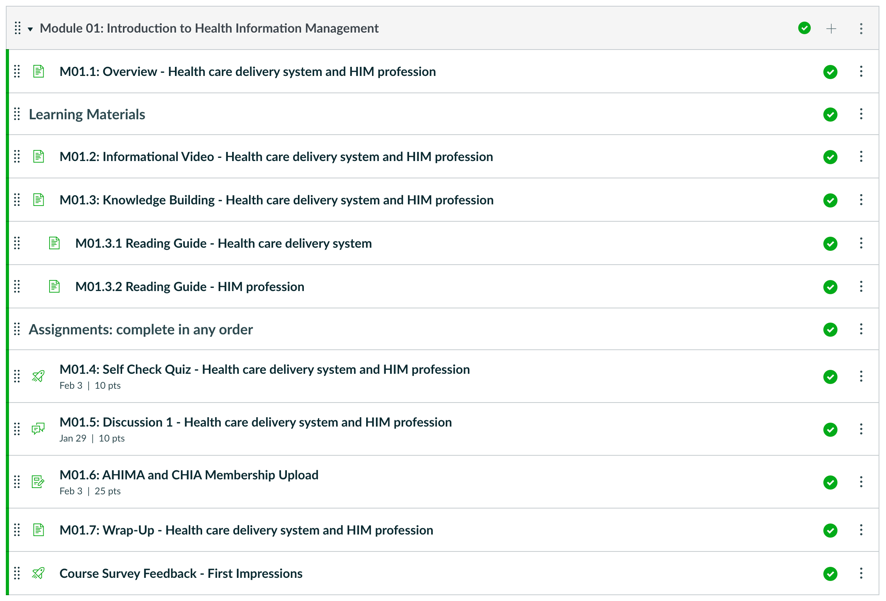
Videos like the one below help guide students to some of the main areas they would be visiting while working through the course content. Students receive guidance from their instructors on how to utilize the information and navigation within their course.
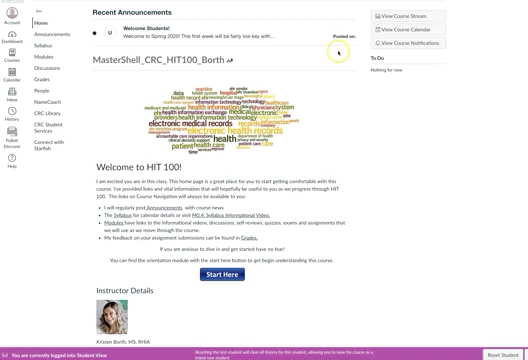
When our courses are easy to navigate and provide guidance on how to learn in an online environment, our students can focus more energy on learning the content provided. And isn’t that the goal, to help students be more knowledgeable on the content we are teaching them?
Author:
Kristen Borth, MS, RHIA
Director & Professor, Department of Health Information Technology
Any opinions, findings, and conclusions or recommendations expressed in this publication are those of the author(s) and do not necessarily reflect the views of the Foothill-De Anza Community College District or those of the California Community College Chancellor's Office.

When the pandemic hit, it raised multiple questions for our institution’s faculty. One of the biggest involved community-building: how do we make sure our students can engage in the same types of conversations they did in the face-to-face classroom? How do we make sure that, even lacking the context of a physical campus, they feel like they “belong” in higher ed?
“Creating videos” was the solution many of us grasped as we struggled to humanize ourselves. But over summer, I grew exhausted from making video content for students. I’d record but suddenly get stuffy and formal and "lectury". Bringing in outside video from YouTube felt inauthentic. Also, I realized that streaming a lot of video was a huge strain on the limited bandwidth of our students, deeply affected by the digital divide.
So, I partnered up with Emily Campbell, Librarian and OER Liaison at College of the Sequoias, and Writability, an openly-licensed podcast, was created. Podcasts seemed to be an ideal solution for a few different reasons: podcast interviews with faculty and staff could create the kinds of informal conversations students were missing in the face-to-face classroom; they used less bandwidth than videos, accommodating our students with data limits and technology access issues; and, finally, they could be flexibly integrated into our students’ lives. Instead of being tied to a computer screen, students could listen and multitask.
The episodes are not lectures, but informal conversations, always with two or more voices, so students are exposed to diverse perspectives. Each episode is a conversation about writing or “colleging” more generally. Topics range from time management, to writing across disciplines, to resume writing, to using Wikipedia effectively. They include tips and explanations, but, because they’re informal, also present a lot of vulnerability on the part of interviewees: colleagues frequently swap stories of their own struggles as students.
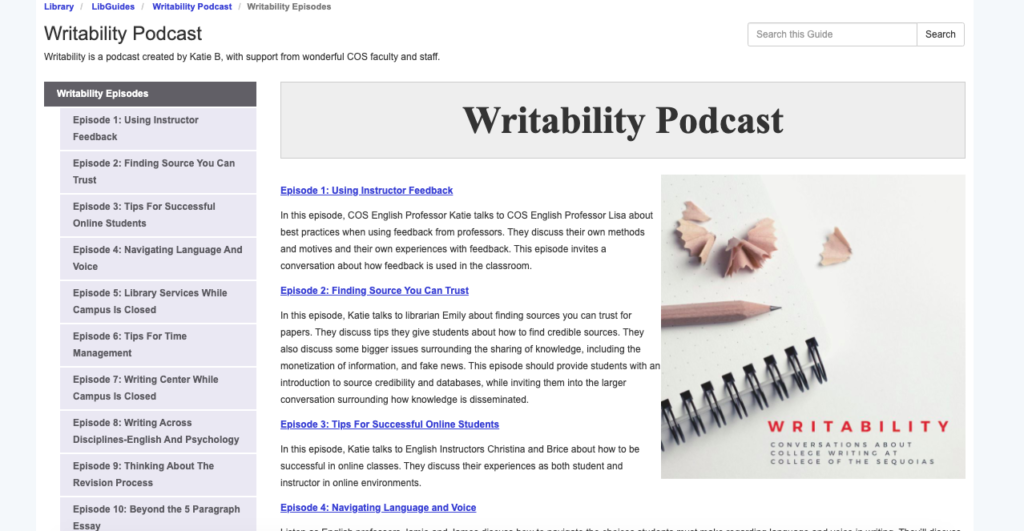
The podcast is supported by Library faculty and is nested in a LibGuide created by COS Librarian Raina Yang. Interviews are recorded over Zoom, which I later edit. We use the Internet Archive to host the audio and episodes are conveniently available on podcast apps.
We are about 17 episodes in and it's going wonderfully. Faculty across campus are using the podcast with a mix of other OERs to reduce the cost of course materials. Some sent out episodes in welcome emails in the beginning of the semester. Others have used them as just-in-time remediation, to support students when they get stuck.
Through feedback, we’ve learned that students enjoy listening and are learning from the episodes. They tell us they aren’t only learning about writing, but also about how to navigate college. They also report realizing that professors are “people too” after listening. Writability not only humanizes us, it inspires our students to persevere and succeed.
Authors:
Katie Beberian
Professor, English Department
Emily Campbell
Librarian & OER Liaison

College of the Canyons is currently building three online programs and improving one existing program to address regional workforce needs. Additionally, we are drawing upon industry expertise to create Open Educational Resources (OER), resulting in Zero Textbook Cost (ZTC) pathways for fields in which none currently exist.
The disciplines currently under development are: Architectural Computer-Aided Drafting, Preschool Teacher, Land Surveying, and Water Systems Technology. The first three programs are not currently offered online, nor do they fully employ OER. By the end of the grant, these programs will not only be fully online pathways, but ZTC as well. The fourth program, Water Systems Technology, is offered online and is built entirely around OER, providing students a full ZTC pathway. For this program, we are improving the quality of existing online courses, updating the OER textbooks, and creating master online course shells.
We are following the model of our successful Water program, which developed a ZTC pathway through original authorship that included strong engagement of industry professionals from across the state. All developed materials will be openly licensed and available to all colleges to adopt and adapt, thereby supporting the training of qualified employees across the state.
Additionally, we have leveraged the expertise of instructional designers to improve the quality and consistency of the student experience by developing master course shells aligned with the OEI Rubric.
The Improving Online CTE Pathways grant has enabled College of the Canyons to meet the needs of students in eliminating the barrier of textbook costs, engaging industry partners to develop relevant instructional materials, and offering high quality, flexible online courses for four in-demand programs. The sharing of these openly licensed courses and materials improve access to fully online, ZTC programs for students across the California Community College System and beyond.
Author:
Joy Shoemate
Interim Director, Online Education
Any opinions, findings, and conclusions or recommendations expressed in this publication are those of the author(s) and do not necessarily reflect the views of the Foothill-De Anza Community College District or those of the California Community College Chancellor's Office.

New World of Work (NWOW) offers a great introduction for students to become aware of 21st-century competencies, digital badging, and the ability to earn badges in courses. The NWOW framework also provides recognition for achievement in skill development through digital micro-credentialing through the Concentric Sky Badgr platform. Embedding 21st-century competencies across curricula to saturate students’ entire college experience highlights and reinforces the importance and interdependence of employability skills in their personal, academic, and professional lives. As part of the Improving Online Pathways (IOP) Grant, Chaffey College developed a framework that extends the opportunities for students to develop competencies and receive achievement recognition through digital micro-credentialing and badging, while streamlining the faculty and administrative process.
Extending the NWOW Framework
To pursue this element of the IOP Grant, Chaffey College reimagined the current NWOW framework and created opportunities to integrate NWOW digital micro-credentials across the curriculum. Chaffey College adapted the NWOW structure to the local institutional context in the following ways:
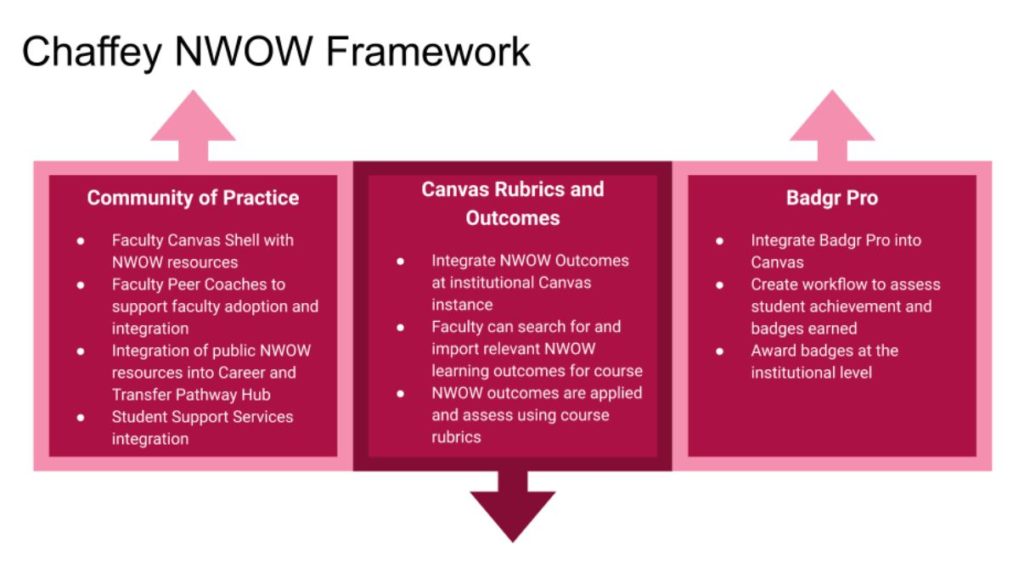
Next Wave of the Revolution
We know that a sustainable model that will allow for a student-first perspective will need institutional and external champions as well as thought-partners. We are collaborating with various academic and student support areas such as the career center, tutoring, library, GE committee, and distance education to identify additional ways to support student exploration and skill development. The response has been overwhelmingly positive. The campus is excited to innovate and pivot to a more responsive and integrative approach.
We are also working within our Region 9 Strong Workforce group to share effective practices and approaches so that other colleges can integrate the extended NWOW framework. This regional approach will allow all to explore integration into student work experiences across the region, digital badge industry acceptance, and increased scalability.
Below are resources to begin exploring integrating NWOW framework as institutional outcomes in Canvas.
Additional Information
Authors:
Matthew Morin, PhD
Director of Intersegmental Partnerships
Trelisa Glazatov, PhD
Curriculum Developer / Instructional Designer
Any opinions, findings, and conclusions or recommendations expressed in this publication are those of the author(s) and do not necessarily reflect the views of the Foothill-De Anza Community College District or those of the California Community College Chancellor's Office.

Non-credit courses might not get the same visibility or accolades as traditional college classes. Still, the value to both students and employers shouldn't be overlooked — especially in light of today's COVID-19 crisis. Non-credit courses give students the option to explore new careers and learn new skills quickly at little to no cost. Non-credit classes also offer a valuable opportunity to partner with employers to create courses that meet their workforce needs, so they can fill roles faster and keep the local economy growing.
Developing non-credit courses can be rewarding for everyone involved, but the process is not always smooth. Let the Cabrillo College team's experience developing a successful non-credit Dental Infection Control Coordinator certificate guide your next course development.
Pre-Planning | 1.5 to 2 Years in Advance
Begin by identifying your goals, timeline, and budget. Currently, Cabrillo College has a plan to increase the number of online programs meeting local workforce needs. The Infection Control Coordinator certificate supports this goal by giving students the chance to build skills in line with local job opportunities that provide a livable wage -- a critical factor for a region like the Bay Area with a high living cost.
Next, identify how you will measure success. Defining success aligns team expectations, makes reporting more straightforward and builds the case for future funding. You'll also want to map out your budget. Cabrillo received the California Virtual Campus – Online Education Initiative (CVC-OEI) Improving Online CTE Pathways Grant to fund the program, and there was a set timeline the team had to follow to meet grant requirements. If you're still waiting on funding or applying for grants, try to identify any prep you can do to aid course development. We'll share more about how this helped the Dental Infection Control Courses.
Research Local Workforce Needs | 1.5 to 2 Years in Advance
Once you set the foundation, research on how to tailor your course for local workforce needs. During this phase, collect labor market information (LMI) and research similar work training programs to prevent duplication. Look for industry trends and changes that may impact the demand for a program or certificate.
In Cabrillo's case, the latest Infection Prevention guidelines from the CDC, OSHA, FDA, EPA, and OSAP (Organization for Safety Asepsis and Prevention) drove the Dental Infection Control certificate. With guidelines and laws required for dental offices, the Cabrillo team led by Noel Kelsch began to conduct surveys with local dental offices to understand how many offices had infection control coordinators on staff and their hiring outlook for the role. For this program, there was not accurate LMI data, so the survey filled the requirement. In addition, the Dental program engaged with potential students to better understand their goals, like increasing earning potential.
Design the Curriculum | 1 to 1.5 Years in Advance
Next, the team developed a curriculum based on their local industry research. The result was a program that would offer an online course and an in-person lab covering topics like the chain of infection, evidence-based guidelines and standards, governing agency regulations, protocols and procedures for infection control, and infection control protocol for a dental office. Although funding for the CVC-OEI grant hadn't arrived yet, the team decided to push the program through the curriculum approval process.
Cabrillo's decision to obtain curriculum approval before the CVC-OEI approved the grant turned out to be critical. When funding arrived a few short months later, Noel and the team were ready to dive into the technical aspect of course design and promotion without delay.
Course Design and Marketing | 6 Months to 1 Year in Advance
Next, the group began working with instructional designers to set up course modules, put together a marketing strategy, and even ran a test pilot of the program to identify and smooth out any issues. The plan was to promote the course in the Spring of 2020 and launch in the Fall of 2020.
The team began making industry and community presentations about the course to local dental associations, school districts, and dental assisting programs to kick-off recruiting students. Cabrillo then launched an English and Spanish campaign on local radio stations, newspapers, web, email, social media, and more.
Open Enrollment & Stay Flexible to Student Needs | 6 Months in Advance
Registration opened and thanks to outreach and marketing seats for the Dental Infection Control Coordinator courses began to fill quickly. Demand was high enough that another section of the online course, DH 460A, was opened. Around this time, the team noticed that Facebook and Twitter drew people from outside their immediate region, including the Southern California towns of Redding and San Diego. The team adapted the in-person lab, DH 460B, to a more flexible weekend date and held all the lab hours in one day so that students could fly in and out in one day.
Anticipating Challenges & Navigating a Pandemic | 6 Months to Start Date
While launching a certificate always has its challenges, no one could have anticipated the full impact of COVID-19.
The pandemic created a new sense of urgency for both potential students and employers. For students, the abrupt economic downturn meant having in-demand skills they could list on their applications rose to the top. At the same time, employers in the dental industry faced new state-mandated health regulations. The Dental Infection Control Coordinator role was more relevant than ever.
The team remained flexible and did its best to adjust to new needs due to the pandemic, keeping a careful eye on how to best support potential students with registration, technology, and scheduling. Lab class size restrictions due to COVID-19, an imperfect registration system, and students coming from across the state were just a few of the team's challenges.
While Noel and the team addressed most problems with flexibility, creativity, and persistence, the California Community College Apply's complex registration system continues to be a hurdle. Today the team is experimenting with streamlining registration using internal forms to batch enroll students into Cabrillo after they have gone through CCC Apply.
As a result of their collective efforts, the team was thrilled to register 64 new students to Cabrillo College. Currently, the two sections of the follow up in-person lab DH 460B are showing 80% enrollment.
Bringing It All Together
Building successful non-credit classes and programs can reap long-term benefits for employers, workers, and the entire community. Non-credit courses give students the ability to increase skills faster than traditional college courses, and employers can quickly hire those students, presenting a win-win for all involved. In the case of Noel and the team, advanced planning and an unwavering commitment to bring the program to life for both students and employers ended up providing a lifeline to the local community during a time of uncertainty. By taking the lessons learned from Noel and the team at Cabrillo, you can start planning your next non-credit program now and better position your college to support your entire local community in the future.
Authors:
Teresa Ruiz Decker
Dream Catch Consulting
Sara Decelle
Online Pathways Grant Manager
Noel Kelsch
Dental Hygiene Director
Any opinions, findings, and conclusions or recommendations expressed in this publication are those of the author(s) and do not necessarily reflect the views of the Foothill-De Anza Community College District or those of the California Community College Chancellor's Office.

Higher education is often viewed as an “ivory tower” – disconnected from the rest of the world, impractical, and concerned with satisfying its own needs and the egos of those who work in the academic world. Bakersfield College is no ivory tower. In my 22 years of service to this great institution, I’ve known hundreds of individuals – smart, talented, and highly educated – who are dedicated to making sure that students reach their goals, whether they want to finish a degree, transfer, or find a great job. My colleagues care more for individual student success than any publication, academic journal, or professional kudos. Their dedication is evident in the time they take, their mindfulness, and their willingness to find each individual who needs help in a crowd of 40,000 students.
However, higher education has historically been bound to an archaic measurement of learning. This measurement, called the “Carnegie Unit”, was first used in 1906. The “unit” tells us how much of something a student has learned, or more accurately how much time they have spent studying it. If we say that a class is three units, it tells us something about how much time we can expect to devote to it. Even if we don’t know how much, we do have a sense that a four-unit class is more work than a one-unit class.
Take a look at a college transcript, if you can – if you don’t happen to have one handy, just search the web for “college transcript”, and you can see some samples. Almost every college transcript has three types of information on it: the names of the classes taken, the number of units assigned to each class, and how many units each class represents.
Now, imagine you are an employer trying to decide if a recently graduated student has learned the skills and knowledge that they will need to be successful at your company. You know they took “Introduction to Business”, they received a “B” grade, and it was three units. Does that tell you what you need to know? Probably not, because the information is not clear or specific. It reminds me of trying to watch a video on my computer when my internet connection is too slow. You can just make it out, if you squint your eyes and use a little imagination. This has been the standard for more than 100 years in higher education, but we have the tools, people, and the technology to do much better.
Last fall, the Academic Technology team at Bakersfield College, partnering with our Career and Technical Education leadership and funded by the California Virtual Campus - Online Education Initiative (CVC-OEI) Improving Online CTE Pathways Grant, launched an innovative effort to provide students and their future employers with a much sharper picture of student learning. Called badges or microcredentials, these digital representations of learning allow employers and students to see a much more detailed view of what happens inside a college course, down to the level of the critical skills and knowledge students will master. In addition to the more detailed view of learning, badges store information such as when and how the skill was measured. This information is authenticated and stored within the badge itself, so students will have ownership of their information and can use it in a resume or personal portfolio of their learning.
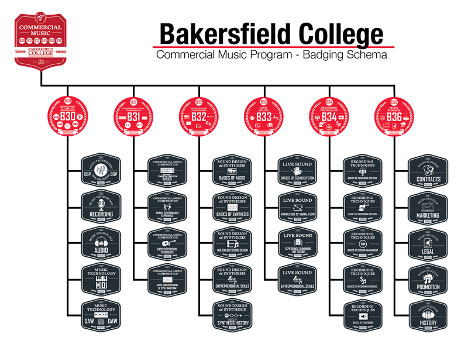
On a larger scale, badges will help to connect students with the critical skills for the jobs they are looking for upon completing their educational journey. There are already several companies who are developing job databases that are searchable by these exact same skill sets. As these develop, students will be able to use their portfolio of badges to search for jobs that match their skill sets.
Already, EMSI and Badgr have formed a partnership that ties workplace skills explicitly to badges, enabling powerful leverage of these credentials to benefit employers and job applicants. Looking ahead, there are still challenges. This type of ecosystem will take a long time to implement, and it will take work to scale this effort up to reach critical mass. This is an inherent mindset shift for faculty, as we move from seat time to attainment. However, there are many parallel movements in education, including assessment work and competency-based learning. Despite the magnitude of the shift we are beginning, there is a great deal of promise in this work.
Author:
Bill Moseley
Dean of Academic Technology
Any opinions, findings, and conclusions or recommendations expressed in this publication are those of the author(s) and do not necessarily reflect the views of the Foothill-De Anza Community College District or those of the California Community College Chancellor's Office.